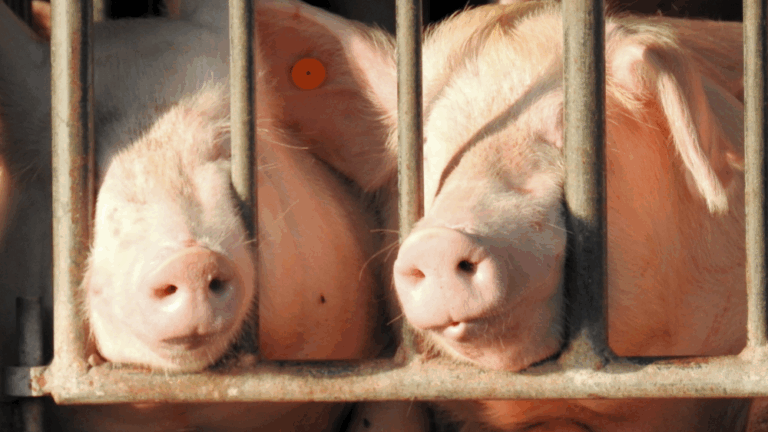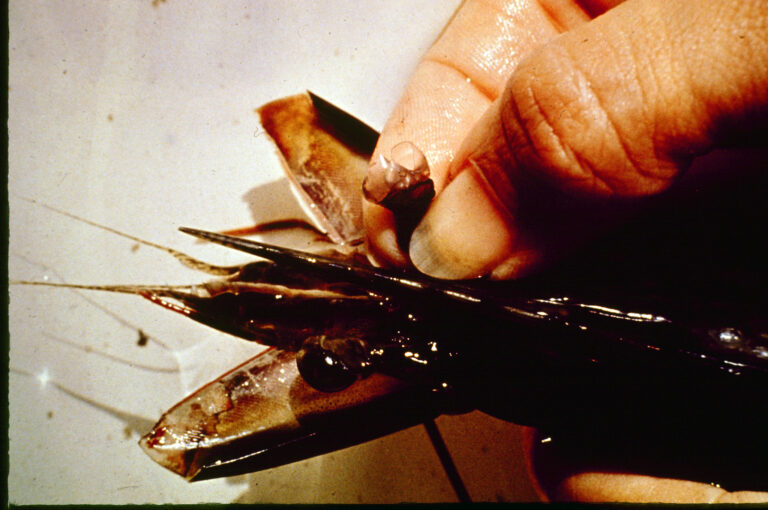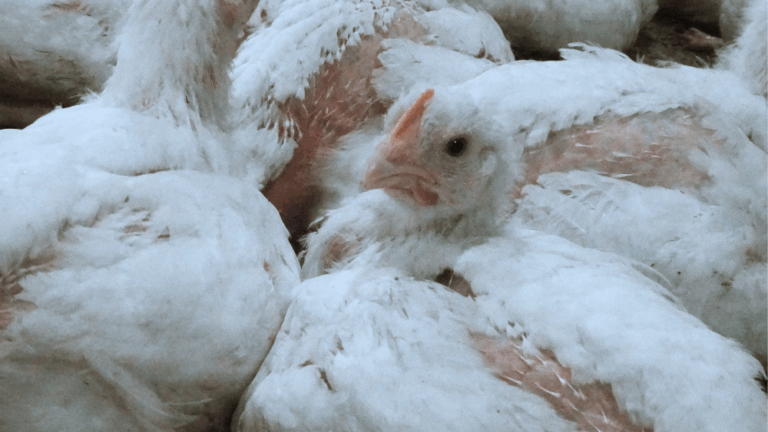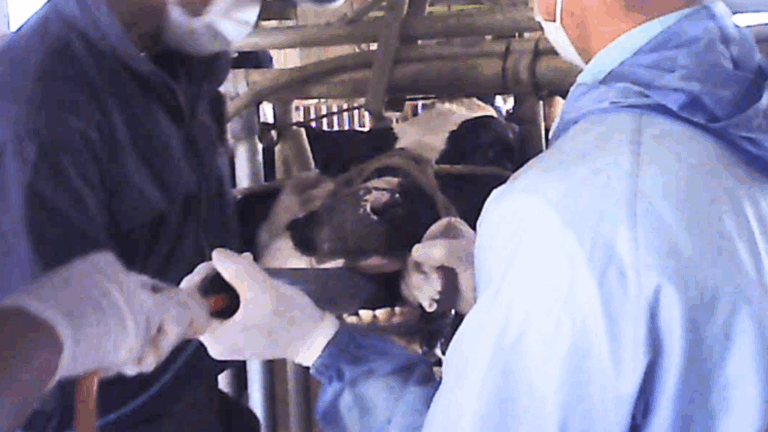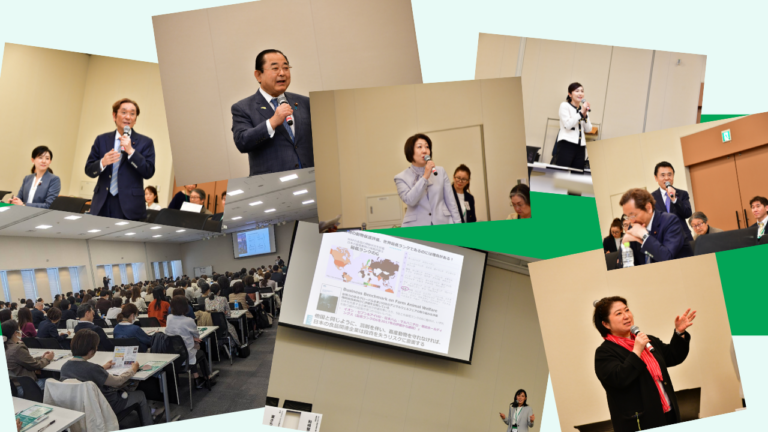Dogs and cats have been subjects of charges with animal cruelty, but other animals continue to be “non-prosecuted” as if they were in a lawless zone.
We can say that the attitude of protecting only dogs and cats and not other animals reflect the low maturity of this country. Some may believe that better treatment of dogs and cats will improve situations for other animals, but this theory is unfounded and the gap has instead kept widening.
However, the penalties of the Act on Welfare and Management of Animals apply to all protected animals, whether they are kept in test facilities, under experiment, confined in livestock farms, or being killed at slaughterhouses.
However, unfortunately, the Act on Welfare and Management of Animals is very difficultly written and hard to judge.
The Ministry of the Environment is trying to develop guidelines for animal cruelty so that the government and police can make decisions. We, Animal Rights Center Japan, together with JAVA and PEACE, are requesting the Ministry of the Environment to clarify some points and make the law usable so that citizens and governments can judge what cruelty is.
Definition of cruelty already issued by the Ministry of the Environment
First, the Ministry of the Environment has already indicated what cruelty is.

However, Japan is currently such a country that this becomes invalid for some reason when it goes to the hands of local government officials. Underestimating the seriousness seems to be the habit.
Our proposal
Overall Request: Please clarify organizational cruelty as cruelty
Animal cruelty can be either of personal nature or due to organizational directions or omission, but failure to crack down on the latter will cause more animals to suffer.
For some reason, abuses committed by individuals are being cracked down, but abuses committed by organizations have slipped through. A society that tolerates when the number of victims of cruelty is large is terrifying. However, that is the case now, that if the number of victims is large, it is considered not “unreasonable” cruelty because it is a common practice. Even though more animals suffer…!
- Cruelty to one cat is a crime
- Cruelty to one parakeet is a crime
- Cruelty to 160,000 chickens isn’t a crime?!
- Cruelty to 1 million chickens isn’t a crime!?
Overall Request: Please clarify responsibility for cruelty at organizational level
In the case of cruelty inflicted systematically by corporations, etc., the performers are employees, but it is often the companies that give instructions and prepare manuals. In this case, Article 48 of the Act states that the corporation is also guilty in addition to the individuals being guilty. However, it is generally difficult to make this judgment.
Overall request: Please do not include natural healing by neglect in the definition of treatment
Regarding “an act of failing to appropriately protect a protected animal which he/she cares for or keeps and which has a disease or is injured”, wounds might close and bones might reconnect if left unattended and the animal does not die, but this is not called treatment and it is necessary to clarify that the penalty provision is applicable.
Overall request: Please give a long-term perspective to debility
The “act of causing debilitation through discontinuation of feeding and/or watering, exploitation of the animal, or restraint of the animal at a place where it is difficult to maintain its health and safety” is carried out over a long period of time, the results are often debilitating, and the effects are often invisible within a day to a month. If there is a possibility of debility after 1-3 years due to abuse, restraint, or keeping method, it is necessary to clarify the applicable cases so that it can be corrected.
Overall request: Please clarify the definition of abuse
The Ministry of Agriculture, Forestry and Fisheries has a guideline for concentrated rearing, but the specifications are abnormal when viewed from an international perspective (that is, when viewed scientifically) and should not be adopted.
Overall request: Please specify that sexual abuse (bestiality, etc.) is prohibited
It is clearly prohibited by foreign law in some cases. It is also happening in Japan, and it is necessary to clarify that this act itself is cruelty.
Overall request: Please clarify that neglect is definitely cracked down as cruelty
Most of the cruelty reports are of neglect, but the law is rarely functioning and guidance sometimes not provided. The awareness of the government officials seems low, so it is necessary to raise it.
Overall request: Please make sure to file a criminal accusation for anything that fits the definition of cruelty
Animal cruelty charges are immediately constructed without any guidance or order, and civil servants are obliged to file criminal accusations immediately when it is discovered.
Request regarding industrial animals: Please correct any self-made exceptions
In “Enforcement of the Act to Partially Amend the Act on the Welfare and Management of Animals (#130 5101, 2015/5/10)”, a notice was given that unfairly stepped into the law: “It should be noted that the handling of livestock in the livestock industry, which is common in Japan, does not fall under cruelty to livestock and the cruelty of keeping livestock in facilities where excrement is accumulated”. It’s certainly usual for the livestock industry to leave manure to constantly accumulate and abuse animals, but the law isn’t working unless it’s penalized in case it’s more than the year-round average. This self-made judgment of the Ministry of the Environment is contrary to the legislative intention, and the law itself is disregarded; this self-made relief cannot be tolerated. The same content was requested on 2019/6/25, but it has not been corrected.
So that “an act of caring for or keeping the animal in a facility which he/she owns where excrement is deposited or where the carcass of another protected animal is left as it is” is a penalty even for industrial animals, we strongly demand returning to the interpretation faithful to the law.
Request regarding industrial animals: Please clarify “unreasonable” and “not-unreasonable” cases
In modern factory animal farming, which is premised on killing, intensive rearing, confined rearing, and painful treatment, it is not possible to judge what constitutes “unreasonable”. It is said that “discrimination is based on the sound common sense of the general public as a social convention”, but this is very vague and we would like it clarified.
| Animal cruelty that cannot be called “unreasonable” | Animal cruelty that is “unreasonable” |
| • An accident that happened once | • Accidents that occurred without taking measures to prevent frequent accidents • Accidents and equipment that repeatedly endanger animals are not being repaired or refurbished. |
| • Animal cruelty where it is the only method, and business can’t be accomplished without it | • Continued animal cruelty despite the fact that there is a remedy and other livestock farmers are accomplishing business while performing it • Cruelty that is unnecessary for the business in the first place |
| • Danger avoidance actions performed when humans are in danger | • Cruelty of constantly using weapons (equipment) installed or possessed for the case of danger to humans |
| • Move or handle parts that are less likely to cause pain | • Moving or handling an animal with a risk of trauma or bone fracture • Moving or handling an animal by imposing distress or fear |
| • Culling by a correct method | • Culling by a wrong or unapproved method • Incomplete killing as a result of a sloppy culling method |
| • Culling untreatable animals | • Abandoning without treatment or culling |
Request regarding industrial animals: Please clarify what’s prohibited, or limit the correct way
The current situation is that neither the government officials nor the police know “what shouldn’t be done” or “the proper method” for the livestock industry. It is necessary to assume that not only the person in charge of animal welfare but also the person in charge of livestock farming has no knowledge. In fact, last year it was surprising to talk to a government official who didn’t even know that chickens were slaughtered on farm on a daily basis. If one doesn’t know the proper method, one would often believe the explanation of the vendors and cannot give guidance.
Requests regarding industrial animals: Please point out treatments of what was common in the past but now has alternatives
Even if a procedure was not considered “unreasonable” in the past, with the development of alternative means and livestock technology, it should be written that it will be considered cruelty. Social convention is changing, and livestock technology for more humane animal handling is evolving day by day (Producers in Japan are too unaware of this!).
Teeth clipping of pigs, treatment and excision without anesthesia, 24-hour lighting, induced molting by completely cutting off water and food, and slaughter without loss of consciousness (stunning) are considered to be applicable. If the OIE Animal Welfare Code is followed, the scope will be even wider.
Other: Making animals fight is cruelty; please make it prosecutable
* We also made requests for cruelty to lab animals, but will leave the details to JAVA and PEACE.



